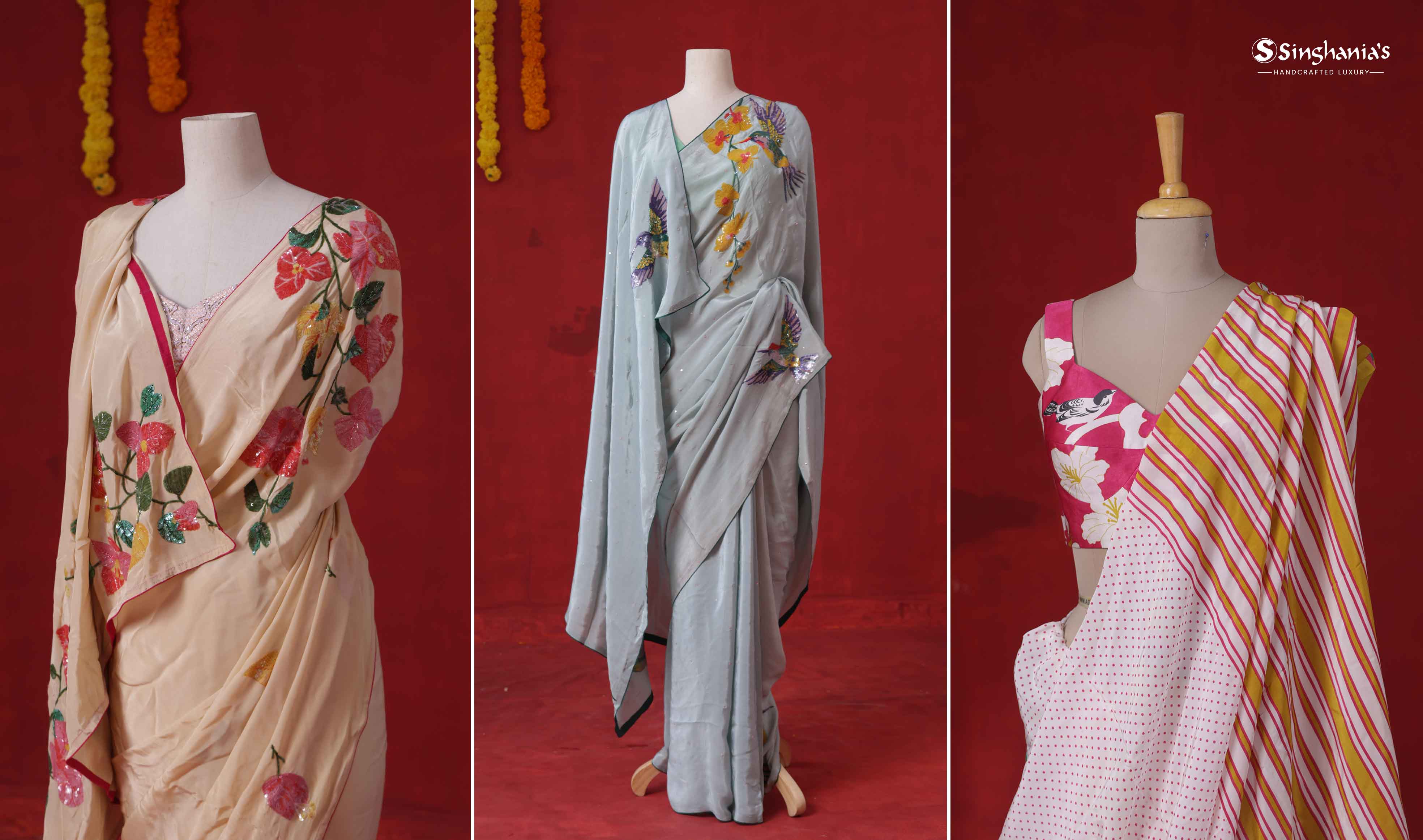
The year 2023 has been monumental for saree fashion. Designers across the country showcased unprecedented creativity through experimental saree designs at prestigious fashion weeks and shows. At Singhania's, we recap the pathbreaking avant-garde sarees that stole the spotlight this year.
These innovative drapes challenged age-old traditions and norms by incorporating non-traditional fabrics, unique construction techniques, and modern styling sensibilities. Blending practicality and artistic flair, designers created a new fashion language that has redefined saree aesthetics.
As pioneers in conceptual saree designs, Singhania's has been an ardent supporter of experimentation that expands the possibilities of draping. Through this article, we decode the elements that made these avant-garde sarees true showstoppers.
Breaking Conventions

Avant-garde saree designs refer to creations that deliberately challenge the usual construction, draping styles, materials and embellishments seen in traditional sarees. These experimental drapes presented a modern twist to the usual saree format seen on runways.
Over the past decades, designers have steadily incorporated new techniques into saree construction. Earlier restricted to traditional six-yard drapes, innovators like Satya Paul introduced pre-stitched sarees in the 60s. In the 90s, experimental designer Gaurang Shah pioneered techniques like using Checks and stripes within the same saree.
However, 2023 has seen saree innovation reach new heights, fully embracing avant-garde aesthetics. Designers have deconstructed the saree to create something utterly modern yet uniquely Indian.
The Elements of Innovation

The experimental sarees this year intrigued audiences by masterfully blending practicality and intricate craftsmanship. The core innovations have been:
Unconventional Fabrics: Designers sourced unusual fabrics like tissue silks, raw silks, crushed silks, and sustainable textiles like Tencel and bamboo rayon. Metallic tissue weaves, Chanderi silks, and lightweight crepes added understated luxury. The use of non-silks like khadi, wool, linen, and brocade was also prominent.
Innovative Draping Styles: Silhouettes like cowl drapes, cape styles, dhoti pants, belt sarees, and unique pre-stitched designs made a statement. Asymmetric hemlines, pleats, knots added dimensional details. While crafting structural innovation, the graceful essence of the saree was retained.
Play of Colors and Patterns

Vibrant, unexpected color combinations and modern motifs elevated the visual impact of avant-garde sarees. Designers clearly pushed the boundaries of conventional aesthetics.
Bold Color Palettes: Color wheel opposites like mustard and ruby, teal and maroon, cobalt and crimson made a striking impact. Monochromatic ombré tones and vibrant jewel tones added excitement. Patterns like ikat and Patola were reimagined in contrasting color stories.
Experimental Patterns: Instead of traditional florals and paisley, designers incorporated abstract prints, asymmetric shapes, geometric patterns, and visual illusions. Gold or silver accent patterns elevated the designs. New context was given to traditional jamdani and bandhej motifs through oversized renditions.
Fusion and Collaboration
One of the highlights of this year was synergy between designers who fused their distinct design philosophies. Cross-cultural inspirations were also prominent.
Cultural Fusion: Designers blended saree construction techniques from across India, merging North and South Indian drapes. Indo-western fusion sarees offered contemporary updates to traditional styles. There were references to the sarees of Persia, Lanka, and Awadh court too.
Designer Collaborations: Renowned designers jointly presented sarees that bore both their signatures, from fabric to embellishment. For instance, Rahul Mishra created Bengal muslin sarees with Sabyasachi's Royal Bengal embroidery. Ritu Kumar collaborated with textile expert Vivienne Tan for Kanchipuram interpretations. These stood out for their fine blending of two design sensibilities.
Saree as Wearable Art

Through exquisite handcrafted embellishment and artistic impressions, the saree was repositioned as a true canvas for wearable art.
Handcrafted Embellishments: Intricate gold zardozi, French knot embroidery, gold and silver Resham work,inrich kantha work elevated sarees into masterpieces. The Jaali work by Rahul Mishra and fabric manipulation by Anavila were engineering marvels.
Saree as Canvas: Designers incorporated artwork, digital printing, Warli art, Kalamkari, along with personal touches like signatures woven into the saree pallu and borders. Picchwai paintings were translated into embroidery. The saree surface was used as a frame for art.
Celebrities Stealing the Show
The appearances of renowned actresses in avant-garde sarees were conversational highlights of fashion weeks. Their experimental ensembles garnered immense praise and attention.
Fashion Week Highlights: Deepika Padukone's metallic pleated saree by Sabyasachi and Alia Bhatt's baby pink Gauri and Nainika saree became the most talked about looks. Sonam Kapoor Ahuja and Katrina Kaif also opted for avant-garde sarees for fashion show ramp walks.
Impact on Trends: Thanks to Deepika's style, similar metallic sarees were seen at weddings and events. Alia's look sparked a wave of millennium pink and retro-inspired drapes. Celebrities enable people to visualise how experimental designs can be styled.
Redefining Tradition

Many designers took inspiration from heritage textiles and techniques like Ikat, integrating them seamlessly with modern aesthetics. Vintage styles were revived in a neo-traditional approach.
Modern Interpretations: Designers like Anavila gave modern twists to traditional saree clothing items like blouses, petticoats and dupattas with backless or crop styles. The anchal was sometimes replaced with cape or jacket styling. Borders and pallu designs were contemporized with asymmetric shapes.
Reviving Vintage: Designers like Payal Singhal, Sanjay Garg and Rimzim Dadu reintroduced vintage styles like the Pochampally Ikat from the 1920s. Old jamdani designs were re-contextualized into modern color palettes. This neo-vintage look blended old world charm with contemporary relevance.
The Future of Saree Fashion

Based on the showcase this past year, it’s evident that experimentation, fusion and breaking norms will drive saree fashion ahead. The avant-garde ensembles have paved the way for more exploration in materials, construction, draping styles, colors and embellishments. Designers now have a much wider canvas to imagine the future of sarees in India.
At Singhania's, we are inspired by this spirit of innovation that has propelled the saree into a new era. Our own lines of conceptual sarees fuse new-age fabrics and styles with high craftsmanship. As pioneers, we look forward to being a part of this journey of constant design evolution that has begun. The future of sarees is truly exciting!
